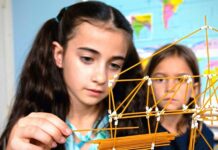Every parent in the world is part of the universal battle that has been going on for centuries: The effort to get your kids to brush their teeth. For kids who think brushing their teeth is just parental tyranny, the war will go on forever. Try Explaining Brushing Teeth to Your Child Like This.
Your best bet for convincing your child to take on their own tooth brushing is to explain what it means, and why it’s important. So today, we’re here to share a few quick and easy approaches to help children understand why tooth brushing matters, and how to brush intelligently to get every stronghold of hidden plaque on purpose.
A good place to start is explaining what plaque really is. In terms your child can understand:
“Plaque is like leftover food on dishes. It gets icky if you don’t clean it off.”
There are lots of ways to explain plaque, from marauding tooth bandits to evil bacteria. But a really effective way is to use a little science experiment. Plaque is basically rotting food and the bacteria that make it rot that is still on your teeth. On a very small scale, it’s doing exactly the same thing as you might see on a dinner plate with a decaying tomato or dried-out pasta salad. Your child instinctively knows that decaying food is bad. So plaque is more easily understood as old food left on a plate that is getting hard and icky at the same time.
You can also explain the nightly tooth brushing like doing the dishes after supper. If you leave the dishes overnight, they get a lot worse to do later. So it’s best to brush every single night before bed.
“Brush your teeth without toothpaste. That’s what plaque tastes like”
Want your child to understand that leaving plaque on their teeth is bad? An easy way to show them is to brush just once without toothpaste. Consider doing this with your child for solidarity, and to talk about what the experience is like. Both of you wet your toothbrushes and brush your teeth clean together. That awful mouth flavor is the taste of the plaque on your teeth. So it’s no wonder why we chose to use minty toothpaste in the first place.
When your child complains, let them stop and explain that that’s the taste of the plaque they’re brushing away. For older kids, you can also explain that brushing without toothpaste is a good way to take stock of the healthy state of their mouth. It doesn’t taste nice, but it can be informative. That’s what your mouth tastes like and that taste even influences how you experience food if you don’t brush before eating.
“Any part of the tooth you don’t brush, that’s where plaque runs to hide. So brush every side”
Once your child understands the concept of brushing off bad-tasting plaque particles, you can explain the surfaces of the tooth. Every tooth is either a cube-like or wedge-like shape with a certain number of surfaces. Top, front, back, and the sides that touch the teeth to either side. It’s important that the toothbrush scrub at every possible surface of the tooth remove that plaque and polish those ivories.
And anywhere the toothbrush doesn’t make it, there is more plaque waiting to spread around the mouth and harden their defenses. Explain to your child that they should seek to brush at all possible angles to make sure the plaque has no place to hide.
“Flossing helps you attack plaque where the toothbrush can’t go”
Finally, flossing is often a whole new battle in the war for tooth hygiene. Not only is it extra, it’s also more physically challenging for children to accomplish. Flosser sticks are a great way to get your kids started, and the best way to make their flossing effective is to explain the purpose: To get those inner surfaces.
Flossing goes where the toothbrush can’t, between the teeth where the narrow passage and vertical surfaces make it impossible for the brushes to get in there. The flosser line needs to rub the plaque off of the insides of the ‘canyon walls’ between their teeth, including the little dip into the gums at the bottom. It helps to rinse flosser sticks after every tooth or three.
—
Children can learn to care about tooth brushing and take care of the task themselves. But first, they have to understand why it’s an important part of personal hygiene. By showing your children what plaque is and why brushing works, they will have a real science-backed reason to take care of their own teeth.

















